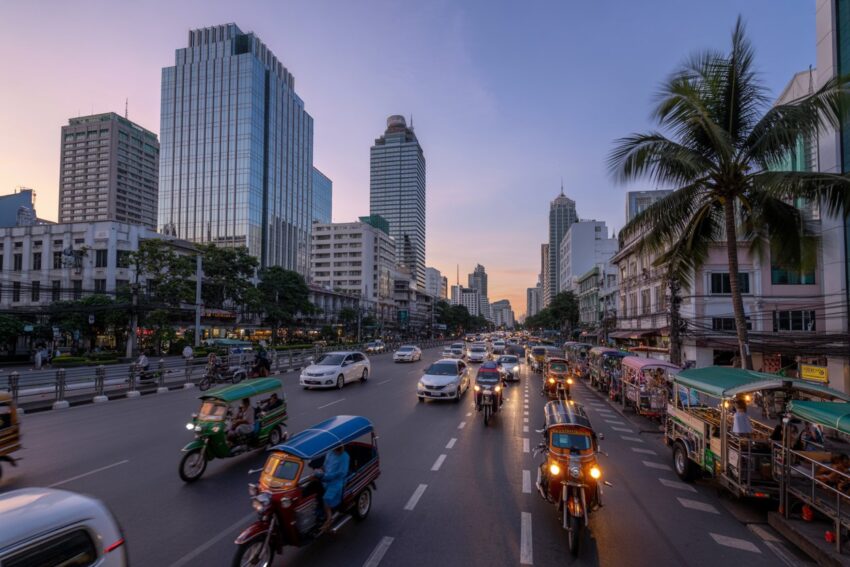Published on
October 7, 2025

As Thailand enters the last quarter of 2025, the government is unveiling its bold Thai government economic stimulus plan to steer the economy back on track. With global economic pressures affecting local markets, the government is rolling out a series of strategic measures under its Quick Big Win initiative. The primary goal is to support businesses, especially small merchants, while boosting domestic consumption and exports boost. This stimulus plan combines short-term relief with long-term growth strategies to help the country recover economically.
The Core of the ‘Quick Big Win’ Stimulus
At the heart of the Thai government’s economic stimulus plan is the Quick Big Win program. This strategy focuses on delivering immediate relief to consumers and businesses. One of the key measures is the Let’s Go Halves Plus scheme, which subsidizes half the cost of goods purchased by individuals, up to 200 baht per person each day. This initiative is set to benefit millions of people by making essential goods more affordable, while at the same time helping to support small merchants across the country by boosting local sales.
This quick-action program aims to give a much-needed boost to consumer spending and, ultimately, Thailand’s GDP. By easing the financial burden on households and encouraging spending, the government hopes to generate momentum for the economy as the year winds down.
Key Features of the Thai Government Economic Stimulus
- Targeted Financial Support: The Let’s Go Halves Plus scheme will allocate 44 billion baht to assist approximately 20 million individuals. This will provide direct relief for daily expenses.
- Support for Small Merchants: The government’s focus on small merchants is a cornerstone of the stimulus, helping them recover by increasing foot traffic and promoting consumer spending.
- Boost to Exports: The plan also includes measures to support the agricultural sector and expand international trade. Negotiations with countries like China, Japan, and Singapore aim to strengthen Thailand’s export markets.
Long-Term Vision for Economic Recovery
While the Thai government’s economic stimulus plan is designed for immediate relief, it is also part of a broader vision for economic recovery. The government is committed to creating lasting growth by fostering a more competitive economy. This includes workforce training programs, particularly in emerging sectors like digital technology, AI, and smart agriculture. These programs aim to upskill workers and prepare Thailand for future economic challenges.
Additionally, the government is addressing household debt and providing easier access to credit for small merchants. By supporting both consumers and businesses, the government is setting the stage for a more resilient economy in the long term.
Maintaining Fiscal Responsibility
Despite the large scale of the Quick Big Win initiative, the Thai government is committed to maintaining fiscal discipline. Deputy Prime Minister Ekniti Nitithanprapas has emphasized that the government will not resort to borrowing to fund these measures. Instead, they plan to use funds already allocated in the 2025 budget.
The government has also set a clear limit on public debt, stating that it will not exceed 70% of GDP unless absolutely necessary. This cautious approach to fiscal policy is designed to provide short-term relief while protecting the country’s long-term economic stability.
Exports Boost and Rural Support
A key element of the Thai government’s economic stimulus plan is the exports boost initiative. The Ministry of Commerce is working to increase trade agreements with major international partners like China and Japan, particularly focusing on rice exports. This will provide a much-needed boost to Thailand’s agricultural sector and contribute to the country’s economic recovery.
The government is also addressing the needs of rural areas, where many small businesses and farmers are struggling. The Blue Flag scheme will help stabilize agricultural prices by absorbing surplus production, which in turn supports farmers’ incomes. In addition, the Let’s Go Halves Plus scheme is designed to help small farmers by increasing demand for their goods.
Additional Measures to Strengthen the Economy
- Healthcare Transparency: Private hospitals will be required to disclose drug prices, allowing consumers to make informed choices and reduce healthcare expenses.
- Supporting Small Merchants: The government is making it easier for small merchants to access financial assistance and credit, providing a safety net for businesses that have struggled during the economic downturn.
Conclusion: A Roadmap to Recovery
In conclusion, the Thai government economic stimulus plan is a comprehensive effort to address both immediate economic challenges and long-term growth. Through initiatives like the Quick Big Win program and the Let’s Go Halves Plus scheme, the government is providing essential support to individuals, small merchants, and key sectors like agriculture and exports. With these measures, the Thai government is working to strengthen the economy and pave the way for sustained economic recovery.
By focusing on both immediate relief and long-term strategic goals, the government aims to create a more resilient economy, one that can withstand future challenges and continue to thrive on the global stage. As Thailand moves forward, the success of these initiatives will play a critical role in ensuring a prosperous economic future.







